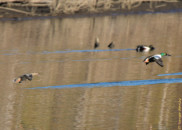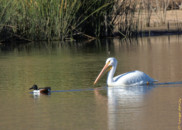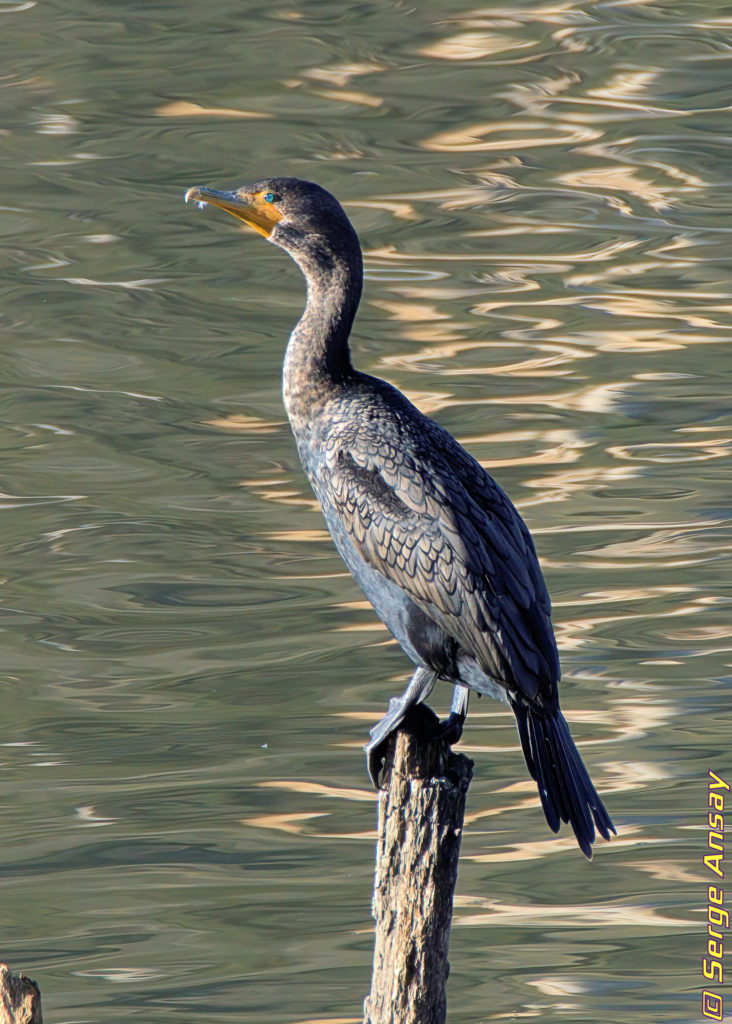As promised I am showing you the second set of pictures taken on Christmas day. It’s always a bit tough for me to decide which picture makes it and which doesn’t. I hesitate for a while looking at the details, the composition, the background, the posture of the animal, and of course, the most important item: the lighting. This essential ingredient of photography is mostly dependent on the sun during the day. And, due to the high power lens I use, I need a lot of light. So, in that regard, this Christmas day was just perfect. It felt like a gift from mother nature. Or rather, many gifts considering the number of animals I was able to catch this time.
Alright, let’s take a close look at our second batch of Christmas gifts 😀





The first bird is a double-crested cormorant. This is a large bird who fishes by diving deep into the water. Thanks to its palmed feet it can swim down to a depth of 1.5–7.5 m (4 ft 11 in–24 ft 7 in) for 30–70 seconds. Its population declined in the 1960s and 1970s due to the intensive usage of DDT as an insecticide in agriculture. The population in the Great Lakes declined to a point where these birds had completely vanished from Lakes Michigan and Superior. Discontinued usage of DDT let the population grow back despite the continuous destruction (news articles like to use euphemisms such as “culling”) by fishermen who see these birds as competitors.
Next we have, once again, a great egret. If you have been following my blog, you will remember a set of pics I posted about a month ago. You can see them, as well as some info about this bird, by clicking here.
The reason I really liked this particular photograph is that it shows the way its neck can fold to a tight S shape and even allow the bird to rest its head on the outer curve of the S. One would think that necks cannot bend this way, but there you go, nature made it happen anyway.
Then, we have a female mallard, which is a kind of duck. As you can see she has her bill shoved under her feathers. She was staying completely immobile. It was early in the morning, around 8 AM, and a bit cold, so I am thinking perhaps she was trying to keep warm.
The next picture shows a couple of mallards flying over the lake. The male is ahead with his shiny green head. The mallard is omnivorous. They will eat all kind of small animals and insects as well as plants, roots, or tubers. They have a lot of predators. The list is so long it’s amazing. It includes raccoons, weasels, snakes, birds of prey, the list goes on and on. The wikipedia article mentions this interesting fact (which I did not know): “The predation-avoidance behaviour of sleeping with one eye open, allowing one brain hemisphere to remain aware while the other half sleeps, was first demonstrated in mallards, although it is believed to be widespread among birds in general.”
I decided to show you the next picture of a mallard being followed by a pelican, at first, just because it seemed odd. But after a minute the mallard turned around and the pelican continued straight ahead as you can see in the second pic. What is interesting though is that the color of the head of the mallard appeared black in the first pic, but green in the second.
The two last pictures show a hummingbird, probably an Anna’s hummingbird. As you will notice in the first pic, his bill seems odd, as if it had been coated with tar. The second pic confirms it beyond the shadow of a doubt. One can see that he’s trying to rub off whatever is on his bill. Perhaps it’s a disease, or really some tar? Whatever the case, this is one thing which occurred to me, every once in while I happen to take pictures of sick animals. These usually don’t make it in this blog because I doubt you really want to see them. Today is an exception, as I think it is important to remember that we need to be careful with the nature that surrounds us. It is more fragile than we think.




That blue eye is very startling!
Interestingly I thought it was green. I just took a closer look, and I think that it’s actually blue-green. So I think that one can see it as either color.
Goodness what a stunning bird. It has a really unique anatomy. What has been your favorite bird to photograph so far?
Thank you. I am assuming you are talking about the cormorant.
Tough question… I loved working on the osprey last week. But that would be unfair to all the other birds. It would be a typical case of “Last love always wins”.
Now that I think about that, I think it’s not the bird by itself that matters. It’s more about what happens, what he/she does, whether it is unique, something that’s rarely caught on camera. That is what is most interesting to me. Bigger birds are easier though. And then, some birds are just so afraid of people, then the reward when you succeed in catching pictures feels like hitting the jackpot. For instance there is this belted kingfisher I have some pictures of, caught from far away and, therefore, lacking details. I have been trying for the last 2 weeks to get better pictures, but he flies away as soon as he sees me, and that’s even though I am very far away already. I am thinking I am going to have to camp in a camouflaged tent for a day to get him. Not sure I have that kind of patience though. Wildlife photography is not always easy.